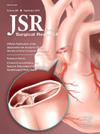Association of Total Body Surface Area and Body Part With Mental Health Outcomes in Pediatric Burn Patients
IF 1.7
3区 医学
Q2 SURGERY
引用次数: 0
Abstract
Introduction
Burn injuries in children are associated with negative impacts on psychological and emotional well-being, yet specific risk indicators are not well researched. We hypothesize that children with greater total body surface area (TBSA) burned and burns in highly visible and functionally significant body parts are more likely to experience negative mental health outcomes compared to their counterparts.
Materials and methods
Database review of 178 pediatric burn patients (median age: 13 ± 2.99) utilizing the Burns Model System National Database, retrospectively collected data between 2010 and 2023. Patient-Reported Outcomes Measurement Information System surveys obtained at 6 mo, 1 y, and 2 y postburn were utilized to assess mental health factors (anxiety, depression, peer relationships, pain interference, fatigue, and physical function). Mental health status was defined using Patient-Reported Outcomes Measurement Information System cut-off points with T-scores. Data were stratified by TBSA quartiles and body part affected (arm, head/neck/face, trunk, perineum, hand, leg, foot). Associations with TBSA and body parts were analyzed with chi-squared calculations using Excel, and demographic data was analyzed using logistic regression using R Studio.
Results
At 1-y postburn, higher TBSA was associated with increased anxiety (P = 0.005), fatigue (P = 0.04), pain interference (P = 0.02), and poorer physical function (P = 0.003); however, there was no correlation with body part burned. By 2 y postburn, the difference in mental health outcomes by TBSA was no longer significant. Increased age was associated with a higher likelihood of depression (P = 0.002) and poorer peer relationships (P = 0.03).
Conclusions
Children with greater TBSA burns or older age were associated with a higher likelihood of mental health consequences by 1 y postburn, regardless of which body part was affected. Understanding these relationships is essential for developing targeted interventions to support the psychological recovery of pediatric burn patients.
小儿烧伤患者体表面积和身体部位与心理健康结局的关系
儿童烧伤与心理和情绪健康的负面影响有关,但具体的风险指标尚未得到很好的研究。我们假设,在高度可见和功能重要的身体部位烧伤的总体表面积(TBSA)较大的儿童与同行相比,更有可能经历负面的心理健康结果。材料和方法利用烧伤模型系统国家数据库回顾性收集2010年至2023年178例儿童烧伤患者(中位年龄:13±2.99岁)的数据。在烧伤后6个月、1年和2年进行的患者报告结果测量信息系统调查被用来评估心理健康因素(焦虑、抑郁、同伴关系、疼痛干扰、疲劳和身体功能)。心理健康状况采用患者报告结果测量信息系统(Patient-Reported Outcomes Measurement Information System)的t分界点来定义。数据按TBSA四分位数和受影响的身体部位(手臂、头/颈/脸、躯干、会阴、手、腿、脚)分层。使用Excel进行卡方计算分析TBSA与身体部位的相关性,使用R Studio进行logistic回归分析人口统计学数据。结果烧伤后1-y, TBSA升高与焦虑(P = 0.005)、疲劳(P = 0.04)、疼痛干扰(P = 0.02)、身体功能差(P = 0.003)相关;然而,与身体部位烧伤无关。烧伤后2个月,TBSA对心理健康结果的影响不再显著。年龄越大,患抑郁症的可能性越大(P = 0.002),同伴关系越差(P = 0.03)。结论:颅脑损伤严重的儿童或年龄较大的儿童在烧伤后1年出现心理健康问题的可能性较高,与身体的哪个部位受到影响无关。了解这些关系对于制定有针对性的干预措施以支持儿科烧伤患者的心理康复至关重要。
本文章由计算机程序翻译,如有差异,请以英文原文为准。
求助全文
约1分钟内获得全文
求助全文
来源期刊
CiteScore
3.90
自引率
4.50%
发文量
627
审稿时长
138 days
期刊介绍:
The Journal of Surgical Research: Clinical and Laboratory Investigation publishes original articles concerned with clinical and laboratory investigations relevant to surgical practice and teaching. The journal emphasizes reports of clinical investigations or fundamental research bearing directly on surgical management that will be of general interest to a broad range of surgeons and surgical researchers. The articles presented need not have been the products of surgeons or of surgical laboratories.
The Journal of Surgical Research also features review articles and special articles relating to educational, research, or social issues of interest to the academic surgical community.

 求助内容:
求助内容: 应助结果提醒方式:
应助结果提醒方式:


